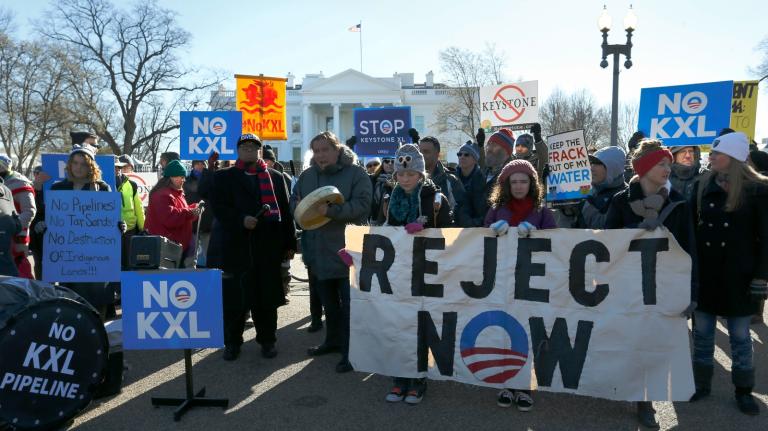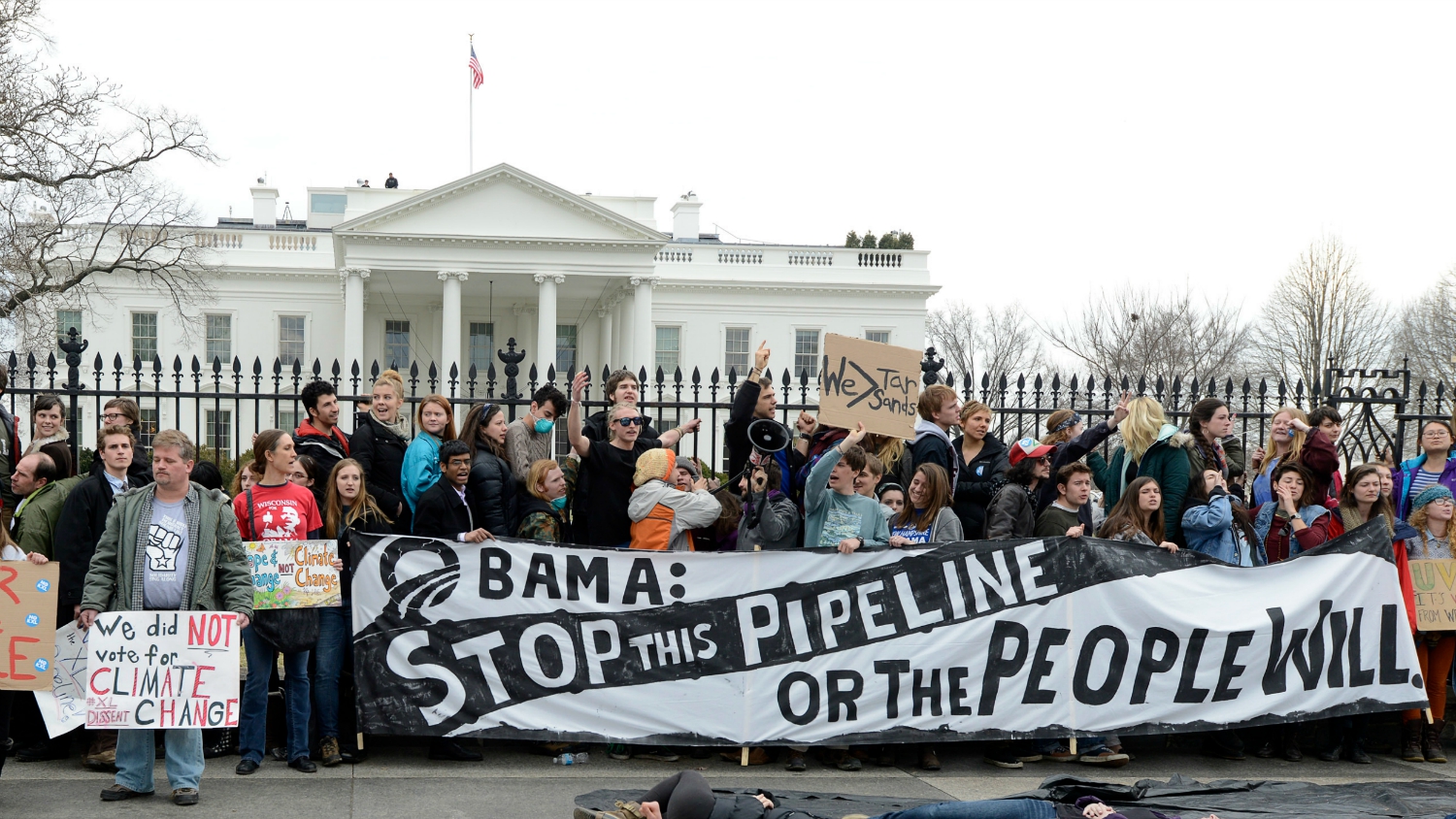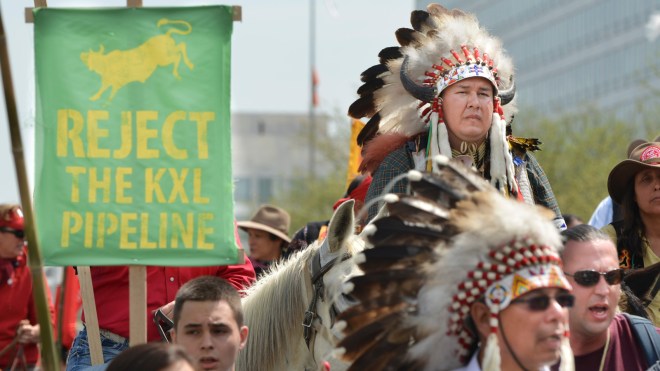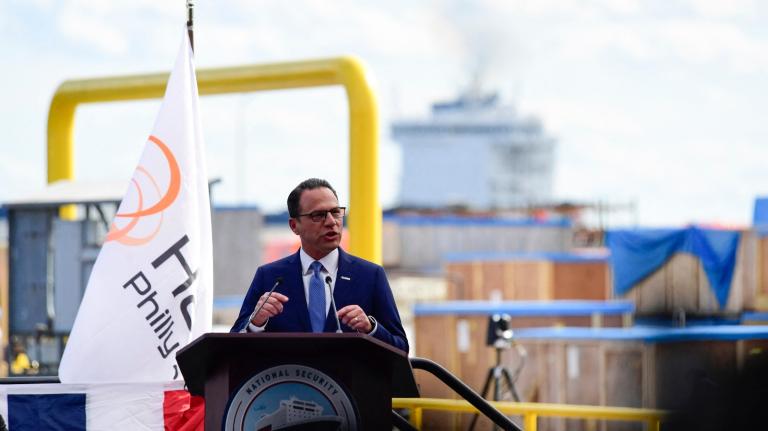Everyone is talking about President Obama’s decision to reject the Keystone XL pipeline proposal, but he’s not actually the hero of the story. The Keystone decision is the culmination of a startlingly successful grassroots activist campaign that defied the odds and convinced the Obama administration to change course against building a major piece of fossil fuel infrastructure. Here’s how it came together, as recounted by a few of the key players.
Pipeline company TransCanada first submitted its application to build Keystone XL (KXL) in 2008, and it was expected to quietly cruise to State Department approval even if Obama won the White House. In 2010, Secretary of State Hillary Clinton said, in a comment that has since become infamous, “we are inclined to” approve it. A previous Keystone pipeline (without “XL” in its name), which goes from Alberta to Illinois, had overcome resistance from environmentalists and indigenous communities in both the U.S. and Canada and been completed in 2010.
The climate movement was still in its early stages at that time, years away from organizing rallies that would bring out 40,000 people in D.C. in 2013 and nearly 400,000 in New York in 2014. Public acceptance of climate science, following the recession and the birth of the Tea Party, was at a nadir in 2010. No one expected that Obama, who had clearly articulated an “all of the above” energy strategy, was likely to be swayed by a campaign against KXL — not even the activists themselves.
And yet, uphill though the struggle would be, some organizers thought the issue had real appeal. It was tangible and easy to understand in a way that power plant regulation is not. And it would not require cooperation from Congress — it was ultimately up to Obama and Obama alone. All they needed to do was convince the president to take their side.
In 2011, when 350.org, the climate action group that would become widely identified with the anti-KXL campaign, glommed onto the issue, there were two groups of activists already working on it: locals from affected communities along the proposed pipeline route, such as ranchers, farmers, and Native Americans, and environmental wonks in Washington, D.C.
“Many stories about the campaign put the start date in mid-2011,” says Kenny Bruno, campaign coordinator at Corporate Ethics International. “But a couple dozen people from environmental groups and tribal nations met in November 2008, two months after the application by TransCanada, and decided to prioritize stopping KXL as a way of fighting the reckless and rapid expansion of the tar sands in Canada. There had been a cry for help from Alberta, where small First Nations and a couple of watchdog groups were seeing this massive expansion of the dirtiest project on earth. And almost no one on earth had heard of it.”
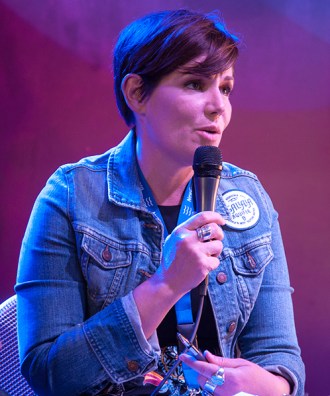
Jane KleebBold Nebraska
Jane Kleeb, founder of Bold Nebraska, a progressive advocacy organization, first became aware of the issue in 2010. “A friend asked if I’d heard about the pipeline that would go through the Sandhills, not because I’m an environmentalist but because Scott’s family homesteaded and still ranches there,” she says, referring to her husband. At the time, Kleeb was a general progressive activist; she had focused on turning out the youth vote in the 2008 election. “I didn’t know what tar sands was,” says Kleeb. “I went to the first State Department hearing in May 2010 in York, Neb., because I was curious. About 100 farmers and ranchers there took the mic and were opposed. The only one who spoke for it was a union guy from Arkansas because his union got construction jobs on Keystone 1,” Kleeb notes wryly. Kleeb decided to get involved in organizing the Nebraska opposition: “I saw this as an opportunity for Bold to really be a voice for rural Nebraska.”
For locals along the proposed pipeline route, the issue had enormous personal significance. Even people whose land was only near the route rather than directly under it faced the danger of land and water contamination from oil spills. This was true of farmers and ranchers in Nebraska and of Native communities in both the U.S. and Canada.
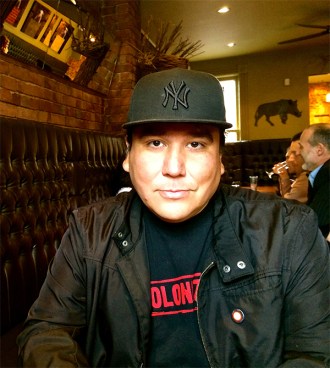
Clayton Thomas-Müller
Clayton Thomas-Müller has been an anti-Keystone leader among First Nations, as Canadian Native American tribes are called. “I was probably the first pipeline campaigner,” he says. Currently the indigenous climate campaigner at 350.org, Thomas-Müller previously ran the anti–tar sands campaign for the Indigenous Environmental Network, based in Ottawa, Ontario. First Nations had been devastated by the effects of tar sands oil extraction and transportation in Alberta and had already been fighting against pipelines for a decade when KXL started to emerge as a big issue in 2010. Having unsuccessfully tried to stop the first Keystone project, Thomas-Müller was well-acquainted with the approval process for a pipeline that goes between the U.S. and Canada and knew the mechanisms that could be used to stop it. He also knew that U.S. tribes could be organized to push on those levers. “I analyzed what it would take to win Keystone XL,” says Thomas-Müller. “I saw that the Ogallala Aquifer was threatened and that was a major wedge with the environmental community, but it also would depend on tribal pushback.”
And so Thomas-Müller and his colleagues started getting tribal councils to pass resolutions opposing Keystone XL. And they took their demands directly to Obama in 2011. “The No. 1 action that we were able to organize during the early years was to organize the tribal chairmen attending the White House tribal leaders summit,” says Thomas-Müller. “Every year Obama has dinner with representatives from every tribal region in the White House. So we found out who the Northern Plains rep was, Rodney Bordeaux of Rosebud [Sioux tribe]. We gave him a declaration opposing Keystone XL that we’d been organizing in Native communities, and he gave it to Obama. There were thousands of signatories.”

Susan Casey-Lefkowitz
Meanwhile, in offices in D.C., environmental policy experts were looking at the new pipelines being proposed and built to carry bitumen extracted from the tar sands, the world’s dirtiest oil, and they were worried. “Back in 2005, I was working with partners in Alberta on other energy issues and I kept hearing about tar sands,” recalls Susan Casey-Lefkowitz, director of programs at the Natural Resources Defense Council (NRDC). “[Its development] was seen by local activists as a source of regret. It was ramping up, and it had a lot of support in the Canadian government and the Bush administration. There was a sense that little could be done to stop tar sands expansion. Groups in the U.S. were not focused on it at all, but groups in Alberta were very concerned. So I started working with NRDC on what it would mean if tar sands oil were extracted. So we mapped out the infrastructure, pipelines and refineries, where tar sands oil would touch down in the U.S. We fought first on Keystone [1] and lost, we fought Alberta Clipper [a pipeline from Alberta to Wisconsin] and lost. The different groups working on fighting tar sands expansion agreed to focus together like a laser on Keystone XL.” That initial coalition consisted of a few national environmental organizations including NRDC, the Sierra Club, and the National Wildlife Federation; First Nations and Native American activist groups such as Idle No More; and Bold Nebraska and local landowner groups.
While the grassroots activists organized from outside D.C., policy experts such as Casey-Lefkowitz focused on the inside game, lobbying the government and conducting the research and analysis that armed activists with data-driven arguments. The experts in federal policy also helped guide the local activists and the grassroots climate activists — many of whom had never been to D.C. or lobbied for anything before — through the political process. “I gave comments on the EIS [environmental impact statement] draft,” says Casey-Lefkowitz, “and we brought environmental experts and indigenous groups down from Canada to talk about impacts of tar sands expansion. We talked about the Enbridge pipeline spill [near] Kalamazoo, Mich., of 1 million gallons of mostly tar sands oil.” The Enbridge spill was an alarming window into the potential future for communities along the KXL pipeline route. “It spilled in the river and has been very, very hard to clean up,” says Casey-Lefkowitz. “The nature of tar sands made it harder for operators to tell there was a leak. The bitumen sinks to the bottom in the river after a leak and cleaning it up creates new oil plumes floating downstream.”
In 2011, in what would become a crucial turning point, renowned NASA climate scientist James Hansen argued in an essay that fully developing the tar sands would mean “game over” for the climate. This was part of a growing recognition at the time that to keep global warming below 2 degrees C, we would need to leave most remaining fossil fuels underground — especially the tar sands oil that is unusually carbon-intensive to extract. That meant the fight over KXL was not just about the risks of local pollution but about the whole planet, and thus the realm of potential activists who could join the fight was huge. It also meant that for those who were already working to stop climate change, there was now a very tangible issue to organize around.
And so a band of little-known activists, without the backing of any billionaires or corporations, set out to convince the White House to reject TransCanada’s proposal on the grounds that it would worsen climate change as well as endanger the local environment.
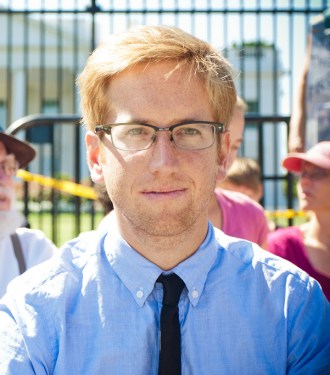
Jamie Henn at a protest in front of the White House in August 2011, before being arrested.Tar Sands Action
“We’d been looking for an issue to deepen resistance [to fossil fuel development] and Keystone XL emerged as the best place to take a stand, in part because it requires a presidential permit,” says Jamie Henn, a cofounder of 350.org and the group’s strategy and communications director. “It’s not Congress’ decision, it was Obama’s alone to make. It was a unique fight, an obvious test, something people could really wrap their heads around.”
When 350.org got involved, it filled the gap between local grassroots activists and national environmental organizations. 350 reached out to the local activists and asked if it would be helpful for the group to raise the temperature on Obama, and the answer was yes. When 350 launched the first major anti-KXL actions in Washington, D.C., in 2011, most reporters hadn’t heard of Keystone XL. That’s one reason the group made the counterintuitive decision to stage the first protest during the last two weeks in August — normally a dead time in the muggy capital. “Congress was on break, so we were the only story in town,” says Henn. “Admittedly, most reporters were on vacation. The first few days I did press and we were ignored by everything but Democracy Now. It was a new issue for reporters.” But not for long.
Each day during that two-week stretch, activists would sit down in front of the White House fence, in a public right-of-way that the police only allow you to occupy for five minutes. The police would come and warn the protesters to leave or face arrest, and they would stay and get arrested — 1,253 of them in total. Though far smaller than the number who might come to a large rally in Washington, D.C., it was a large number for such an intense act of civil disobedience. The spectacle in such a high-profile location drew media attention. “We saw how it began to break through,” says Henn. “People hadn’t seen something like this done before on climate.”
Kleeb brought a contingent of Nebraskans to D.C. for that August protest. “We were doing work in [Nebraska] and Bill McKibben, who I didn’t know of because I didn’t come from that world, sent a letter out with Naomi Klein,” she says. “It was simple, beautiful, and strong, calling on people to come to D.C. and get arrested, so we could start to get the president’s attention on this issue. For some of our farmers and ranchers, it was their first time flying, let alone in D.C. It was the first time for all these Nebraskans doing civil disobedience, getting arrested.”
350 took lessons from other activists more experienced in civil disobedience. “We deliberately connected [KXL] to civil rights,” says Henn. “Dan Choi showed up on the first day and said this is the type of action that can push the administration.” Choi is the former Army lieutenant and Iraq War vet who came out as gay and campaigned through similar high-profile acts of civil disobedience for repealing “Don’t Ask, Don’t Tell.” “We learned from civil rights and LGBT groups who were beginning to make headway pressuring the administration. Environmentalists were probably the last ones to learn that to make progress on this administration, you had to push them hard.”
A potential setback, followed by the first temporary victory, came shortly thereafter. In November 2011, the State Department issued an environmental impact statement (EIS) that was very favorable toward the proposal. “Everybody was telling us, ‘There’s no way you’re going to win,’ so we figured we’d go back to D.C. and we had 15,000 people surround the White House,” says Henn. 350.org linked up with groups that had larger email lists like the Sierra Club, MoveOn, and Avaaz.org, and managed to bring out an impressively large number of people. The demonstration proved that environmental activists cared deeply about the issue. Meanwhile, the EPA pointed out analytical flaws in State’s EIS. Those two events together had their desired effect on the administration, which delayed the decision on KXL, saying it needed to look at possible alternative routes.
That success brought blowback. After the national media portrayed the left as having some success stalling the approval of Keystone, the right took up the pro-pipeline cause. “Once that delay happened, it was sealed that Keystone XL was going to be this national fight,” says Henn. “Suddenly there were reporters on the beat and anything said about the pipeline was a headline on Fox News. Congress pushed the administration to make a decision and the administration pushed back and said it needed [a more thorough] review.” 350.org mobilized its troops for a 24-hour, 800,000-message call-in to the Senate in February 2012. On the other side, Republican presidential nominee Mitt Romney promised in April 2012, “I will build that pipeline if I have to myself.”
TransCanada reacted to the controversy by splitting the Keystone XL project in two. It decided to build the southern leg from Cushing, Okla., to the Gulf Coast separately because that part wouldn’t cross an international border and therefore didn’t require approval from the State Department or the White House. Obama — who was then running for reelection and emphasizing his commitment to boosting oil production — let State keep analyzing the northern leg of KXL. But in March 2012, he went to Cushing and said he was going to expedite permitting for the southern leg. Climate activists still remember the betrayal with bitterness. “It was Obama’s worst speech on climate ever,” says Henn.
But the following summer, after he was safely reelected, Obama shifted the terms of the debate again, this time in the climate movement’s favor. In a speech at Georgetown University, Obama laid out a climate test for KXL. He won’t approve it, he said, if it will “significantly exacerbate the problem of carbon pollution.”
“That was a turning point, because Obama helped cement something we’d been saying all along: You can’t approve this if it’s going to hurt the climate,” Henn recalls. “That said to us, ‘OK, we’re on our turf here.’ It isn’t a debate about jobs, about the American economy, about energy independence — it’s about climate change. That’s a debate we can win.”
Says Bruno, “Prior to that, most elite opinion held that a piece of infrastructure was not a core climate issue, and that tar sands would ‘come out of the ground anyway.’ The Georgetown speech meant we had won the argument about whether infrastructure locking in high-carbon investments was important. Evaluating KXL on its climate impact was all we could have asked for, and the president promised that would happen. That night I felt we had won the campaign.”
But they still had to convince the administration that KXL would, in fact, exacerbate climate change by encouraging oil extraction from the tar sands. If the State Department found that the tar sands would be exploited anyway, then Obama would have cover to OK the pipeline. Even though the president started pointing out how miniscule any economic benefit from KXL would be, he was still uncertain of the climate impact.
And so things looked pretty grim in January 2014, when the State Department issued its revised EIS. The statement, strongly contested by environmental activists, argued that the tar sands would be developed whether or not KXL was built. So the pipeline, State concluded, would have no impact on climate change. The activists pushed back with studies showing that the cost of transporting tar sands oil without KXL would be prohibitive. They were publicly insistent that they would win the argument, but some were privately discouraged.
Still, they pushed forward. In April 2014, the entire anti-KXL coalition came together for a week of events on the National Mall — between the White House and the Capitol — called “Reject and Protect.” The theme was “Cowboys and Indians,” after the ranchers and Native Americans who both joined in. The Native American groups put up tepees where visitors could stop in and be educated about the issue. The week culminated in a rally and march with real-life cowboys and Indians riding horses. “That was the first time the White House acknowledged our work,” Kleeb wryly remembers. “I got an email from the White House saying, ‘OK, you’ve got our attention.’ They literally said that.”
The cowboy and Indian alliance was not just cobbled together for that event. It had grown out of a Native American summit about a year earlier. “I was at an event at the casino on the Rosebud reservation [in South Dakota] in early 2013,” Kleeb recalls. “It was a community forum where everyone was sharing information. One of the elders talked about the cowboy and Indian alliance that stopped uranium mining in the ‘80s. So I went to tribal leaders and said we should revive the cowboy and Indian alliance and do events along the pipeline route. We did a concert with Willie Nelson and Neil Young, and ‘Reject and Protect’ on the Mall.”
The collaboration between historical antagonists, both icons of the American West, gave the opposition to KXL a broader national political appeal. “Those faces are not the image you usually have of the environmental movement,” says Kleeb. “We were helping the White House understand that there was political space [to] reject it.”
And so they did. As First Nations and other groups stalled plans to build other pipelines in Canada to move tar sands oil east or west, and as oil prices dropped to a point where it would be uneconomical to extract tar sands oil if it needed to be shipped by rail, the argument that KXL would have no climate impact grew steadily weaker. While Obama continued to play his cards close to his vest, it began to look like he would eventually reject KXL. By late 2014 and early 2015 he was speaking very skeptically about the project, explaining how it wouldn’t lower U.S. gasoline prices and calling tar sands oil “extraordinarily dirty.”
The last gasp of the pro-KXL crowd came this past winter when the new Republican Congress made passing a bill that would require KXL approval their first act. Obama vetoed it. “We started to feel confident when Obama rejected the bill in Congress this Feb. 24,” says Henn.
Polarization works both ways: Just as environmental opposition inspired Republicans’ obsession with building Keystone, so did Republican efforts to take away the president’s authority spur Obama to push back. “Once Congress really took the reins on this, it’s John Boehner’s pipeline as much TransCanada’s,” says Henn. “That might have changed the political calculus for the White House: ‘We can’t do this without looking like we’re doing Boehner a favor.’ I would say Republicans did us a favor by banging the drum so loudly.”
“What really made it the most famous pipeline never built was the GOP, which seized on it thinking it was a weak point for the president,” says Bruno. “In my view, their obsession backfired because it alerted the president that something didn’t add up — it just wasn’t that important a project in terms of jobs, energy security, etc. Eventually he saw through the hype.”
A Keystone-style victory won’t necessarily be easy to replicate in other anti–fossil fuel fights. Some battles won’t attract unlikely allies like ranchers and farmers, and many issues aren’t so easy to explain to potential supporters and don’t lend themselves to simple slogans on protest signs.
Still, this fight shows that activists can take on the fossil fuel economy and win. “When we were starting against Keystone XL, we were told over and over again, ‘You can’t do this, you can’t win, why are you doing it?’” says Casey-Lefkowitz. “Sometimes you tackle those fights like Keystone XL and the world around you changes, and it catches up to where you are.”
